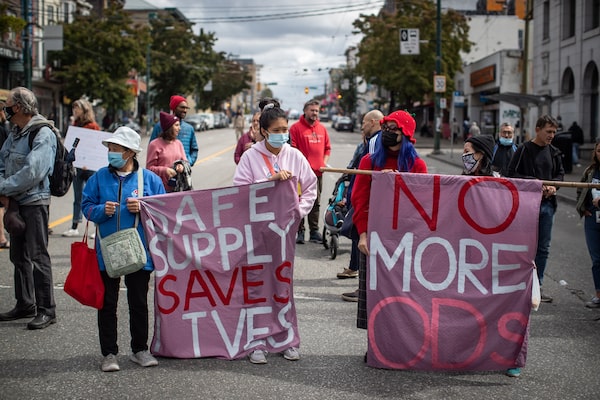
People hold banners during a march to remember those who died during the overdose crisis and to call for a safe supply of illicit drugs on International Overdose Awareness Day, in Vancouver, on Aug. 31, 2021.DARRYL DYCK/The Canadian Press
British Columbians who were at risk of death related to illicit opioid use were 61-per-cent less likely to die from any cause in the following week if prescribed at least one day’s supply of a pharmaceutical alternative, according to new research.
The study, published this week in the British Medical Journal, is the first to evaluate the controversial strategy, commonly called “safer supply,” at a population level. The research looked at anonymized data from 5,882 people with either opioid or stimulant use disorder and who had filled a prescription as part of B.C.’s program between March, 2020, and August, 2021.
The health outcomes of participants were then compared with a control group that was constructed to be as similar as possible – using linked administrative health data from a cohort of all B.C. residents with a record of opioid or stimulant use disorder in the last 25 years – that did not receive these medications.
The research found participants were 55-per-cent less likely to die from a drug overdose. As well, therapeutic benefit increased with the number of days they were prescribed, with those receiving four or more days of prescribed opioids 91-per-cent less likely to die form any cause the following week, and 89-per-cent less likely to die from an overdose.
The safer-supply strategy was introduced as “risk mitigation guidance” in B.C. in March, 2020, in response to heightened overdose risks during the COVID-19 pandemic. It has since become part of the province’s overall approach to combat record deaths from a toxic, illicit drug supply that has become awash with deadly fentanyl.
The British Medical Journal study is a collaboration between scientists and public health professionals from the BC Centre for Disease Control, the Centre for Advancing Health Outcomes, the First Nations Health Authority, the BC Centre on Substance Use (BCCSU), the University of Victoria’s Canadian Institute for Substance Use Research, Simon Fraser University and the University of British Columbia.
Amanda Slaunwhite, a senior scientist with the BCCDC, said researchers had hypothesized the effectiveness of the medications but were surprised by its extent.
“When we think about our response to the overdose crisis and, of course, the large number of deaths that we’ve seen in recent years, that we have an intervention that was implemented that is showing such a protective effect against deaths is really encouraging,” she said in an interview Thursday.
Of 5,882 people, 5,356 were dispensed an opioid medication, 1,061 were dispensed a stimulant medication and 535 people received both. Dr. Slaunwhite said that while stimulant outcomes were “pointing in the right direction,” such dispensations were not significantly associated with reduced deaths and there was not enough of a sample size to say protective effects would hold.
B.C. is now eight years into a toxic drug crisis that has killed about 14,000 people. Safer supply has become one of the province’s – and Canada’s – most controversial responses, with supporters saying a regulated supply is the most impactful and immediate response possible. Critics, meanwhile, say it is a counterintuitive measure that could exacerbate problems.
B.C. rejects coroner panel’s call to expand access to safer-supply program
B.C. clinicians point to limits of safer-supply program in draft report
While the intervention has received much attention, it remains largely inaccessible to most. The study noted there were about 70,360 people with opioid use disorder and 41,890 people with stimulant disorders in B.C., meaning just 7.6 and 2.5 per cent of those people were prescribed alternatives during the study timeframe.
The number of people prescribed an opioid as part of this program each month peaked at 4,945 last March and fell to 4,265 in November.
Provincial Health Officer Bonnie Henry announced in June that she would review the program after concerns about its limitations and potential unintended consequences, such as its medications falling into the wrong hands.
The Globe and Mail reported in November about the findings of Dr. Henry’s province-wide consultations with clinicians over the summer. She is expected to release recommendations to government in the coming weeks.
This week’s research is a “watershed publication,” said Paxton Bach, co-medical director at the BCCSU and a clinical assistant professor in the Department of Medicine at the University of British Columbia.
“This provides the strongest evidence thus far supporting this intervention, and that gives me at least some reassurance as a clinician, as a prescriber, all the while still leaving many other unanswered questions that remain important.”
The BC Coroners Service says there is no indication that prescribed safer supply is contributing to overdose deaths, and Dr. Bach said there is continuing surveillance to examine unintended consequences.